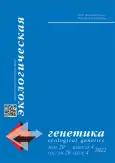Diversity of PsSym29 and PsNRLK1 genes in the VIR germplasm collection of pea (Pisum sativum L.)
- Authors: Zhukov V.A.1,2,3, Zhernakov A.I.1,2, Belozerova M.Y.2, Dodueva I.E.2, Lebedeva M.A.2, Lutova L.A.2, Tikhonovich I.A.1,2
-
Affiliations:
- All-Russia Research Institute for Agricultural Microbiology
- Saint Petersburg State University
- Sirius University of Science and Technology
- Issue: Vol 20, No 4 (2022)
- Pages: 271-278
- Section: Genetic basis of ecosystems evolution
- URL: https://journals.rcsi.science/ecolgenet/article/view/132237
- DOI: https://doi.org/10.17816/ecogen111959
- ID: 132237
Cite item
Abstract
BACKGROUND: N.I. Vavilov Institute of Plant Genetic Resources (VIR) (Saint Petersburg, Russia) maintains a large collection of pea (Pisum sativum L.). Earlier, several growth and yield parameters were recorded for plants of 99 accessions grown under inoculation with nodule bacteria and arbuscular mycorrhizal fungi.
MATERIALS AND METHODS: Polymorphism of genes encoding symbiotic receptor kinase PsSym29 [participating in the autoregulation of nodulation (AON) system] and closely related receptor kinase PsNRLK1 (with yet unknown function in symbiosis) was assessed in 99 pea genotypes from the VIR collection. Nucleotide diversity, Tajima’s D, and Fay and Wu’s H statistics were calculated using DNAsp 5.0 software. The significance of associations of allelic state of the sequenced genes with the growth and yield parameters was tested by two-way ANOVA followed by FDR correction and by regression analysis.
RESULTS: Nucleotide diversity and the ratio of synonymous to non-synonymous substitutions was greater in PsNRLK1 as compared to PsSym29. The analysis of Fay and Wu’s H in sliding window revealed signatures of positive selection in one site of PsSym29 and in three sites of PsNRLK1 gene sequences located in 1st exons encoding LRR (leucine rich repeat) domains. No significant associations of allelic state of neither PsSym29 nor PsNRLK1 genes was found with plant growth and yield parameters.
CONCLUSIONS: The sequences of both PsSym29 and PsNRLK1 genes undergo positive selection, but the conditions in which specific allelic states of the genes become adaptive are to be elucidated in future.
Full Text
##article.viewOnOriginalSite##About the authors
Vladimir A. Zhukov
All-Russia Research Institute for Agricultural Microbiology; Saint Petersburg State University; Sirius University of Science and Technology
Author for correspondence.
Email: vzhukov@arriam.ru
ORCID iD: 0000-0002-2411-9191
SPIN-code: 2610-3670
Scopus Author ID: 35325957900
Cand. Sci. (Biol.), PhD, Leading Research Associate, Head of the Laboratory of Genetics of Plant-Microbe Interactions
Russian Federation, Saint Petersburg; Saint Petersburg; Saint PetersburgAleksandr I. Zhernakov
All-Russia Research Institute for Agricultural Microbiology; Saint Petersburg State University
Email: AZhernakov@arriam.ru
ORCID iD: 0000-0001-8961-9317
Scopus Author ID: 16403813100
Junior Research Associate, Laboratory of Genetics of Plant-Microbe Interactions
Russian Federation, Saint Petersburg; Saint PetersburgMaria Yu. Belozerova
Saint Petersburg State University
Email: m-kitty@mail.ru
Student
Russian Federation, Saint PetersburgIrina E. Dodueva
Saint Petersburg State University
Email: wildtype@yandex.ru
SPIN-code: 8061-2388
PhD, Cand. Sci. (Biol.), Associate Professor, Department of Genetics and Biotechnology
Russian Federation, Saint PetersburgMaria A. Lebedeva
Saint Petersburg State University
Email: mary_osipova@mail.ru
SPIN-code: 6000-6307
PhD, Cand. Sci. (Biol.), Senior Research Associate, Department of Genetics and Biotechnology
Russian Federation, Saint PetersburgLudmila A. Lutova
Saint Petersburg State University
Email: la.lutova@gmail.com
SPIN-code: 3685-7136
Dr. Sci. (Biol.), Professor, Department of Genetics and Biotechnology
Russian Federation, Saint PetersburgIgor A. Tikhonovich
All-Russia Research Institute for Agricultural Microbiology; Saint Petersburg State University
Email: igor.tikhonovich49@mail.ru
SPIN-code: 6685-9419
Dr. Sci. (Biol.), Professor RAS, Dean of Faculty of Biology
Russian Federation, Saint Petersburg; Saint PetersburgReferences
- Tsyganov VE, Tsyganova AV. Symbiotic Regulatory Genes Controlling Nodule Development in Pisum sativum L. Plants. 2020;9(12):1741. doi: 10.3390/plants9121741
- Smýkal P, Coyne C, Redden R, Maxted N. Genetic and Genomic Resources of Grain Legume Improvement: 3. Elsevier, 2013. 77 p.
- Sinjushin A, Semenova E, Vishnyakova M. Usage of morphological mutations for improvement of a garden pea (Pisum sativum): the experience of breeding in Russia. Agronomy. 2022;12(3):544. doi: 10.3390/agronomy12030544
- Yakobi LM, Kukalev AS, Ushakov KV, et al. Polimorfizm form gorokha posevnogo po ehffektivnosti simbioza s ehndomikoriznym gribom Glomus sp. v usloviyakh inokulyatsii rizobiyami. Agricultural Biology. 2000;35(3):94–102. (In Russ.)
- Zhukov VA, Zhernakov AI, Sulima AS, et al. Association study of symbiotic genes in pea (Pisum sativum L.) cultivars grown in symbiotic conditions. Agronomy. 2021;11(11):2368. doi: 10.3390/agronomy11112368
- Roy S, Liu W, Nandety RS, et al. Celebrating 20 years of genetic discoveries in legume nodulation and symbiotic nitrogen fixation. Plant Cell. 2020;32(1):15–41. doi: 10.1105/tpc.19.00279
- Laffont C, De Cuyper C, Fromentin J, et al. MtNRLK1, a CLAVATA1-like leucine-rich repeat receptor-like kinase upregulated during nodulation in Medicago truncatula. Sci Rep. 2018;8(1):2046. doi: 10.1038/s41598-018-20359-4
- Sulima AS, Zhukov VA, Afonin AA, et al. Selection signatures in the first exon of paralogous receptor kinase genes from the sym2 region of the Pisum sativum L. Genome. Front Plant Sci. 2017;8:1957. doi: 10.3389/fpls.2017.01957
- Untergasser A, Nijveen H, Rao X, et al. Primer3Plus, an enhanced web interface to Primer3. Nucleic Acids Res. 2007;35(S2): W71–W74. doi: 10.1093/nar/gkm306
- Tamura K, Peterson D, Peterson N, et al. MEGA5: molecular evolutionary genetics analysis using maximum likelihood, evolutionary distance, and maximum parsimony methods. Mol Biol Evol. 2011;28(10):2731–2739. doi: 10.1093/molbev/msr121
- Librado P, Rozas J. DnaSP v5: a software for comprehensive analysis of DNA polymorphism data. Bioinformatics. 2009;25(11): 1451–1452. doi: 10.1093/bioinformatics/btp187
- Nei M, Gojobori T. Simple methods for estimating the numbers of synonymous and nonsynonymous nucleotide substitutions. Mol Biol Evol. 1986;3(5):418–426. doi: 10.1093/oxfordjournals.molbev.a040410
- Ng PC, Henikoff S. SIFT: Predicting amino acid changes that affect protein function. Nucleic Acids Res. 2003;31(13):3812–3814. doi: 10.1093/nar/gkg509
- Alves-Carvalho S, Aubert G, Carrère S, et al. Full-length de novo assembly of RNA-seq data in pea (Pisum sativum L.) provides a gene expression atlas and gives insights into root nodulation in this species. Plant J. 2015;84(1):1–19. doi: 10.1111/tpj.12967
- Schnabel E, Journet E-P, de Carvalho-Niebel F, et al. The Medicago truncatula SUNN gene encodes a CLV1-like leucine-rich repeat receptor kinase that regulates nodule number and root length. Plant Mol Biol. 2005;58(6):809–822. doi: 10.1007/s11103-005-8102-y
Supplementary files








